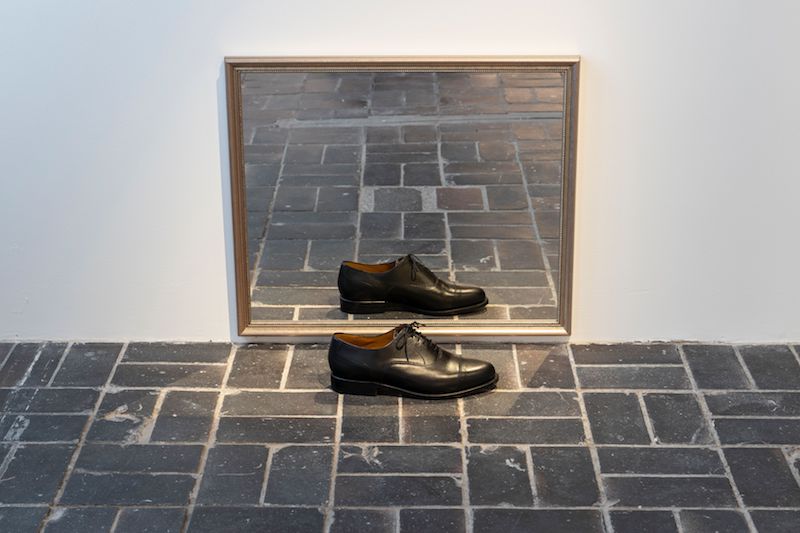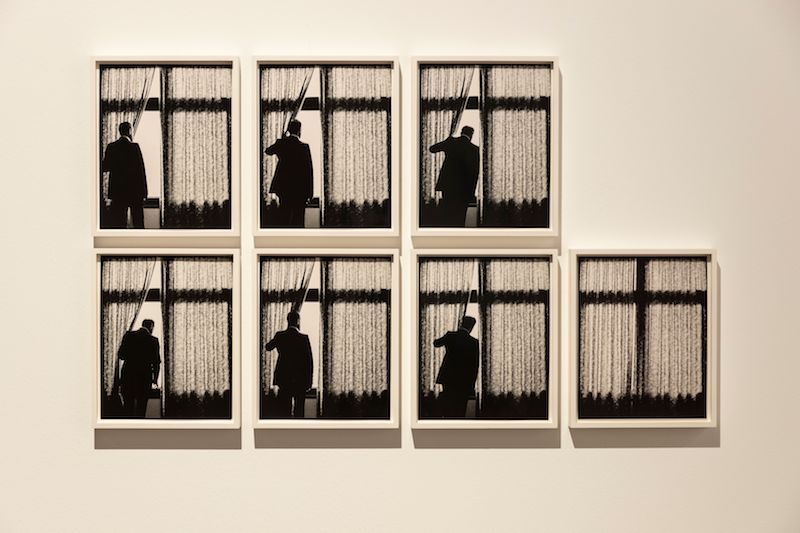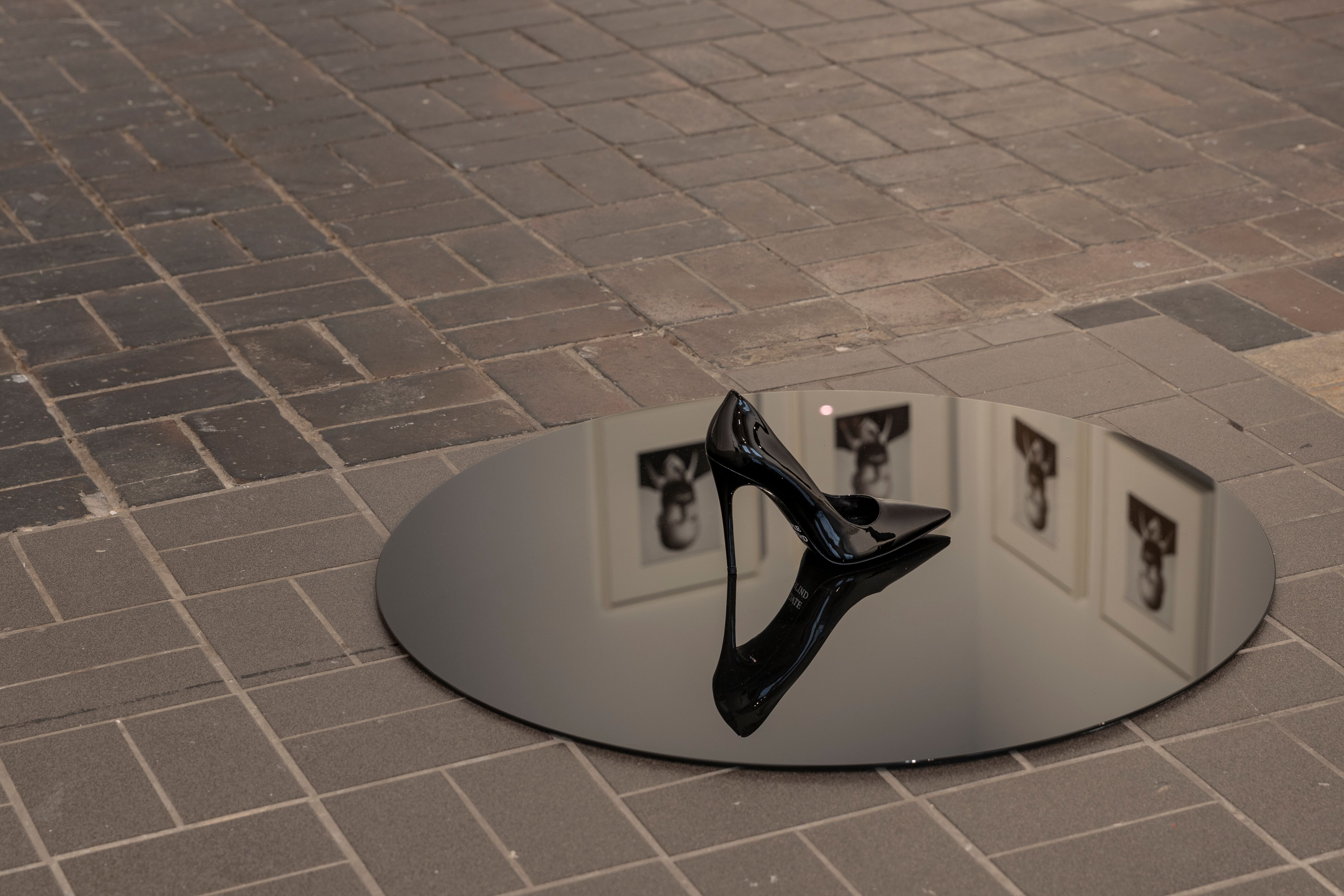Article by Martha Lochhead // Nov. 01, 2019
Influential Icelandic contemporary artist Hreinn Friðfinnsson’s exhibition ‘To Catch a Fish with a Song’ at KW Institute celebrates over half a century of his work. The exhibition is playful and encourages the viewer to create narratives within artworks and across the exhibition space, often by highlighting the passage of time. Friðfinnsson also conveys his perspective on natural phenomena, drawing back to his Icelandic roots and his father’s farm, on which he grew up. The work exhibited includes photographs, drawings, paintings, videos, text, sculpture, installation and ready-mades. Some of his ready-mades are mundane, everyday objects used in a poetic and evocative way that prompts simultaneous confusion and delight.

Hreinn Friðfinnsson: ‘A Pair,’ 2004-2005, installation view at KW Institute for Contemporary Art // Photo by Frank Sperling, Courtesy of Antonio Dalle Nogare Collection, Bozen (IT)
Friðfinnsson was a founding member of the Icelandic artist collective SÚM, which came into being in 1965 and disbanded in the late 1970s. The young group of artists took inspiration from abroad. Inspired by contemporary international art—including the likes of Duchamp and his ready-mades, pop-art and avant-garde movements such as Fluxus—they operated against the classical styles of watercolour and oil paintings that dominated Iceland’s art scene in the 1960s. They were harshly criticised, receiving many negative reviews. The public even requested that the government should cease grant payment unless the artist could paint; this goes some way in demonstrating how SÚM represented a complete backlash to Icelandic art.
The exhibition spans two floors of the KW, with his early works, in which the disruptive influence of SÚM is evident, located downstairs, and later works displayed upstairs. Works pertaining to his well-known, ongoing ‘House Project’ extend over both floors. Photos depict the project in its multiple forms: as the inside-out house and the reimagined structural beams of the house. The artwork was inspired by Icelandic author Þórbergur Þórðarsonfrom’s novel ‘Íslenskur aðall,’ (Icelandic Aristocracy) published in 1938, in which a character named Solon Gudmundsson, an old eccentric who lives in a fishing village, builds a house inside out. Solon Gudmundsson insists that the wallpaper should go on the outside so that everyone can see it. In 1974, Friðfinnsson began his project by building a small house like Gudmundsson’s, with wallpaper on the outside and corrugated iron on the inside. Thus “the wide world” is reduced to the small room confined by the roof and walls of the house, while the “inside” contains everything. The photos depict a small, isolated and lonely house. The house has a dreamlike quality, like something from a fairytale or ethereal poem. At the same time, it supposedly contains everything and is thus the centre, or starting point, of the world, perhaps not so lonely after all. It both evokes the joy of a whimsical eccentric story and poses deeper philosophical questions about the world.

Hreinn Friðfinnsson: ‘First House,’ 1974 // Courtesy of the Artist, and i8 Gallery, Reykjavik, Galerie Nordenhake, Berlin, Stockholm, Mexico City, Meessen De Clercq, Brussels, Galería Elba Ben í tez, Madrid
Another of his long-term projects ‘I Collected Personal Secrets,’ which spanned over 40 years (1972-2015), is exhibited along with its conclusion. The artist collected secrets from people and received letters and CDs. True to his word, Friðfinnsson states that he never read the secrets. The culmination of the project is an installation featuring all of the secrets shredded and fixed together. If you examine the pieces you may spot a word here and there, such as “London”; it teases visitors with secrets they will never know.
His work often gestures towards a story but encourages the viewer to create their own narrative. ‘A Place’ is a series of two photos of the same mundane room from the same angle. Underneath one is the sentence ‘A place of failure and disappointment’ and under the other is ‘A place of hope and expectation.’ Friðfinnsson cleverly opens the viewer’s imagination so that we may speculate on the narrative; the story created depends on the order in which the photos are read. ‘A Place,’ like many of his works on display, speaks to the poetic.

Hreinn Friðfinnsson: ‘Seven Times,’ 1978-1979, installation view at KW Institute of Contemporary Art // Photo by Frank Sperling, courtesy of Kverneland Folger ø Sammlung, Berlin
‘Drawing a Tiger’ is a heart-warming portrayal of the passage of Friðfinnsson’s life as an artist. In the first, he is a young boy ‘Drawing a Tiger Iceland 1952.’ In the next version, the artist as an older man partakes in the same act, and mimics the position of his younger self, underneath the words ‘Drawing a Tiger in Holland 1971.’ The series is enchanting, it offers a sort of dramatic irony wherein the viewer knows something that Friðfinnsson, practising his craft as a young boy, does not: that he will succeed as an artist.
The second floor of the exhibition displays more of Friðfinnsson’s sculptural work. One heeled stiletto sits upon a black circular shiny surface, the words ‘BLIND DATE’ are reflected by the black surface. The words may be easily missed if the gallery is crowded, or if we look from a certain angle. When the words catch the eye it’s as if we have uncovered a secret. The words are painted onto the shoe backwards so that they can be read the right way round in the reflection. The connotations of a single lost shoe suggest a humorous 21st-century Cinderella story; a forgotten stiletto from a blind date.

Hreinn Friðfinnsson: ‘Blind Date,’ 2015, installation view at KW Institute for Contemporary Art // Photo by Frank Sperling, courtesy of the Artist and Galerie Nordenhake Berlin/ Stockholm/ Mexico City
In this incredibly aesthetically pleasing exhibition, the viewer is guided through the artist’s joyful and humorous contemplations on subjects ranging from his childhood home, landscapes and secrets, to cobwebs from all of his former studio spaces. The works that span across his entire career link together with a reoccurring use of the three primary colours, as well as similar shapes and mirrors images. New narratives may be formed within individual works of art, and comparatively between multiple pieces. Not dissimilarly to Duchamp, who SÚM took inspiration from, the exhibition stimulates new associations with and contemplations about mundane objects. As for the title of the exhibition, an intriguing image, mimics the artist’s somewhat absurdist, playful storytelling and poetic transcendence of the mundane.
Exhibition Info
KW INSTITUTE FOR CONTEMPORARY ART
Hreinn Friðfinnsson: ‘To Catch a Fish with a Song’
Exhibition: Sept. 28 2019 – Jan. 05, 2020
Auguststraße 69, 10117 Berlin, click here for map



















